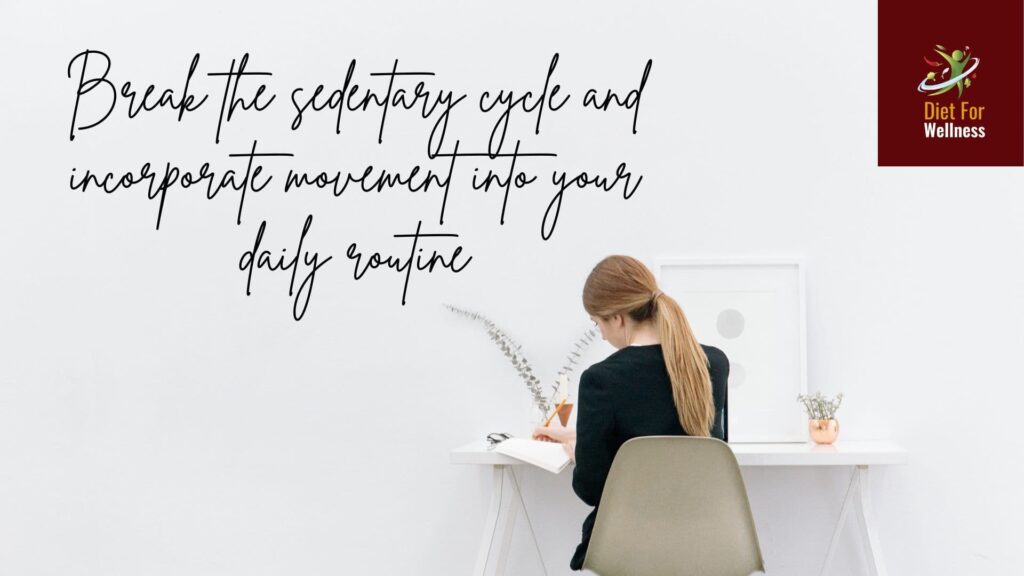Breaking the Sedentary Lifestyle and Staying Healthy Despite Desk Work

Living in 2024 sedentary desk jobs have become the norm, contributing to a lifestyle that can detrimentally affect our health and well-being. Yet, with a touch of creativity and conscious effort, integrating physical activity into our daily routines, even amidst desk work, is entirely feasible.
Most of us, these days find ourselves spending a significant portion of our day sitting at a desk, whether it’s in an office, at home, or in a classroom. While this sedentary lifestyle may seem inevitable, it can have detrimental effects on our health if not properly managed. However, breaking the sedentary cycle is possible with some simple changes and mindful practices.
But before that, it is important to understand the risks associated with prolonged sitting. Research has linked sedentary behavior to various health issues, including obesity, heart disease, diabetes, and even mental health problems like depression and anxiety. Additionally, sitting for long periods can lead to muscle stiffness, poor posture, and decreased flexibility, which can further exacerbate discomfort and increase the risk of injury.
Incorporating Movement into Your Day
The key to breaking the sedentary cycle is to incorporate movement into your daily routine, even while working at a desk. Check out these strategies to help you stay active throughout the day-
Take Regular Breaks- Set reminders to stand up and stretch every hour. Even a short break can help improve circulation, reduce muscle tension, and boost energy levels.
Desk Exercises- Incorporate simple exercises that can be done at your desk, such as seated leg lifts, desk push-ups, or shoulder rolls. These movements can help counteract the negative effects of sitting and promote strength and flexibility.
Walk Whenever Possible- Take advantage of any opportunity to walk, whether it’s to the water cooler, restroom, or during your lunch break. Consider having walking meetings or taking phone calls while walking to add more steps to your day.
Use a Standing Desk- If possible, invest in a standing desk or a convertible desk that allows you to alternate between sitting and standing throughout the day. Standing desks can help reduce prolonged sitting and promote better posture and circulation.
Incorporate Active Commuting- If feasible, consider biking, walking, or using public transportation for your daily commute. This can add more physical activity to your day and help break the sedentary cycle before you even reach your desk.
Prioritizing Ergonomics
In addition to incorporating movement, it’s essential to prioritize ergonomics to prevent discomfort and reduce the risk of musculoskeletal issues. Some ergonomic tips for a healthier workspace are as follows-
Adjust Your Chair- Ensure your chair provides proper support for your lower back, and adjust the height so that your feet are flat on the floor and your knees are at a 90-degree angle.
Position Your Monitor- Place your computer monitor at eye level and about arm’s length away to reduce strain on your neck and eyes. Use a document holder if you need to reference papers while typing.
Maintain Neutral Posture- Sit with your back straight, shoulders relaxed, and elbows close to your body. Keep your wrists straight and level with your keyboard to prevent wrist strain.
Organize Your Workspace- Keep frequently used items within easy reach to minimize excessive reaching and twisting. Use a headset for phone calls to avoid cradling the phone between your neck and shoulder.
Cultivating a Healthy Mindset
This is crucial for breaking the sedentary cycle and maintaining overall well-being. Practice mindfulness and self-awareness to recognize when you need to take breaks and listen to your body’s signals. Set realistic goals for incorporating movement into your day and celebrate your progress along the way. Remember that consistency is key, and small changes can lead to significant improvements over time.
Breaking the sedentary cycle requires conscious effort and commitment, but the benefits to your physical and mental health are well worth it. Stand up, stretch, and take a step towards a healthier, happier you!
